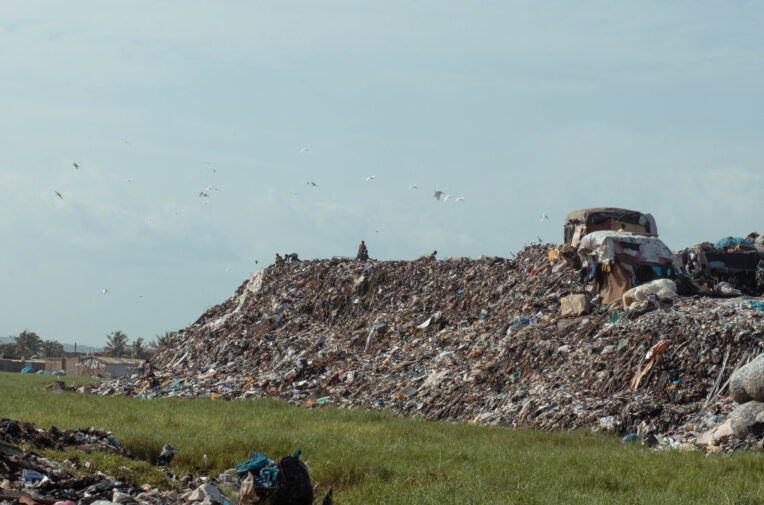
Wastepickers are seen at a roughly four-year-old textile dump site in Glefe, inside the Densu Delta protected wetlands, outside Accra, Ghana. © Michael Takyi Lartey / Unearthed / Greenpeace
Discarded clothing from Next, Asda, and M&S found in protected wetlands threatened by new waste dumps near Ghana’s capital
Discarded clothing from Next, Asda, and M&S found in protected wetlands threatened by new waste dumps near Ghana’s capital
Wastepickers are seen at a roughly four-year-old textile dump site in Glefe, inside the Densu Delta protected wetlands, outside Accra, Ghana. © Michael Takyi Lartey / Unearthed / Greenpeace
Clothes discarded by UK consumers and shipped to Ghana have been found in protected wetlands, an Unearthed and Greenpeace Africa investigation can reveal.
Unearthed reporters found garments from Next, George at Asda, and Marks & Spencer in the wetlands, home to three species of sea turtles. The clothes were in, or close to, two recently-established dump sites filled with used clothing inside an internationally recognised wetland an hour outside Ghana’s capital city, Accra.
Locals complain that their fishing nets, waterways and beaches are clogged with synthetic fast fashion exported to Ghana from the UK and Europe.
In a third dump on the banks of the river leading to the conservation site, Unearthed reporters found garments from M&S, Zara, H&M, and Primark.
The fashion labels acknowledged that the industry faces challenges around processing textile waste. M&S, George, and Primark said they run “take-back” schemes to help address the issue. H&M, Zara, and George said they would support an extended producer responsibility framework to hold labels accountable for their products’ end-of-life impact.
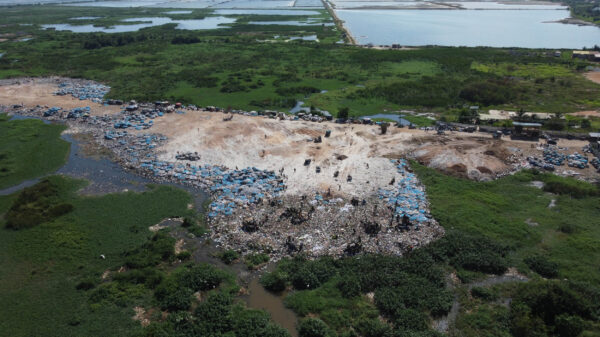 Akkaway dump is less than a year old, and sits at the edge of the Densu Delta protected wetlands, outside Accra, Ghana. Piles of waste sit on earth stripped of its vegetation, close to lagoons and streams. The dump is unlined and has no visible pollution mitigation systems. © Samuel Baidoo / Unearthed / Greenpeace
Akkaway dump is less than a year old, and sits at the edge of the Densu Delta protected wetlands, outside Accra, Ghana. Piles of waste sit on earth stripped of its vegetation, close to lagoons and streams. The dump is unlined and has no visible pollution mitigation systems. © Samuel Baidoo / Unearthed / Greenpeace
As the world’s largest importer of used clothing, Ghana has earned the grim title of the global “fast fashion graveyard”: 15 million items of discarded garments arrive each week. The UK sent more fashion waste to Ghana last year – 57,000 tonnes according to UN trade data – than to any other country except the UAE, which is a hub for re-export. But local officials estimate about 40% of each bale is unusable– torn, stained, or unsuitable for the climate. This overspill has overwhelmed Accra, creating shocking scenes: tangled clothes carpet city beaches, and line canals in mounds so massive they resemble cliffs.
Unearthed’s investigation reveals that new dump sites are mushrooming beyond urban areas – including in pristine conservation areas that are critical for wildlife and local communities who rely on the wetlands as a source of food and income. Reporters also found textile waste, including UK labels, elsewhere in the wetlands, tangled in vegetation, half-buried in sand, and in waste washed up at a beach resort where a manager told us he burns piles of clothes weekly.
[We used to see] alligators, bush cats… All kinds of birds and rabbits too…[Now] when it rains, there are so many mosquitoes and the smell – it’s very bad
“Dumping of refuse at any part of the wetland contravenes best international conservation protocols,” said Eric Atta-Kusi, wetlands operations manager at Ghana’s Forestry Commission. “The local assembly have been made to understand the negative implications of dumping of waste materials in the wetlands on, not only the fauna and flora but also the impact on the free flow, a major contributing factor to the flooding situation in the area.”
The local assemblies did not respond to a request for comment by the time of publication.
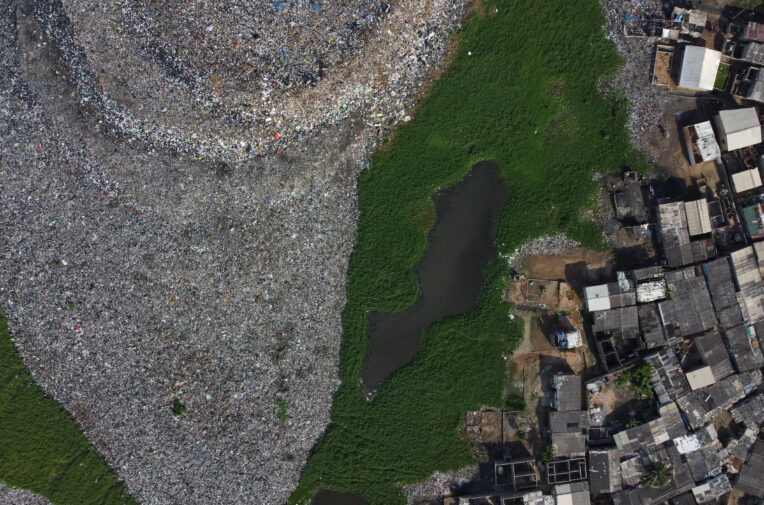 A roughly four-year-old textile dump site in Glefe, inside the Densu Delta protected wetlands, outside Accra, Ghana. The area is designated a “Ramsar site”: a wetland of "international importance" under the Convention on Wetlands. © Samuel Baidoo / Unearthed / Greenpeace
A roughly four-year-old textile dump site in Glefe, inside the Densu Delta protected wetlands, outside Accra, Ghana. The area is designated a “Ramsar site”: a wetland of "international importance" under the Convention on Wetlands. © Samuel Baidoo / Unearthed / Greenpeace
Tests performed last year by Greenpeace Africa using infrared scanning suggest that the vast majority of clothes found in Accra’s textile dumps are made from synthetic fibres. These are produced from petroleum and can take centuries to break down, releasing microplastics and chemicals as they decompose. Dumpsites visited and verified by Unearthed as containing mostly textile waste covered 40 hectares, the equivalent of about 50 football pitches, according to a model trained on Picterra, a geospatial AI platform.
Plummeting quality
At the heart of Ghana’s used clothing trade is Kantamanto, one of the biggest second-hand clothes markets in the world. In early January, a huge fire devastated more than 60% of the market, affecting 10,000 people, according to non-profit organisation the Or Foundation.
Before the fire, traders sorted and sold clothes from 55 kg imported bales, for which they paid between £116 and £185 depending on the types of garments inside, competing fiercely for quality pieces.
For decades, this trade has provided jobs for traders and affordable clothing for locals. But as fast fashion – cheap, poorly made clothes, worn a handful of times then dumped – has proliferated, the volume of clothing has soared while the quality has plummeted. Trade statistics show that UK exports of second-hand clothes to Ghana have increased by 77% in ten years, but over the same period, the value of each kilogramme of these exports has dropped 15%.
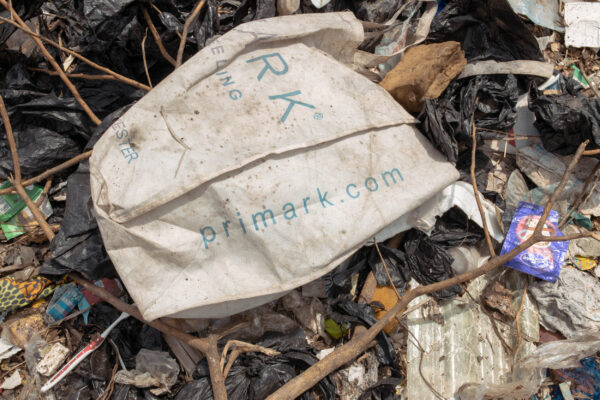 A bag from Primark, found in the Weija Ashbread landfill, an older textile dump site sited on the Densu river, upriver from the protected wetlands, outside Accra, Ghana. © Michael Takyi Lartey / Unearthed / Greenpeace
A bag from Primark, found in the Weija Ashbread landfill, an older textile dump site sited on the Densu river, upriver from the protected wetlands, outside Accra, Ghana. © Michael Takyi Lartey / Unearthed / Greenpeace
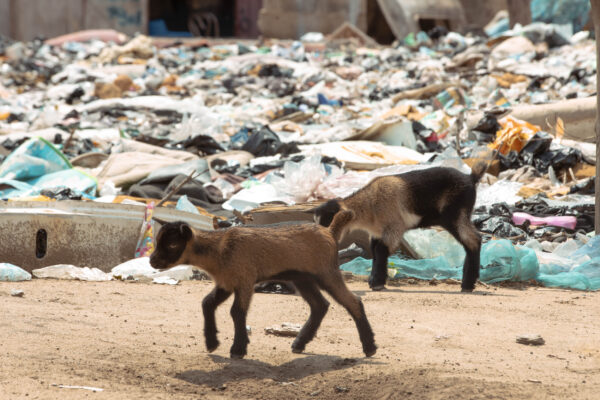 Baby goats at the Weija Ashbread landfill, an older textile dump site upriver from the Densu Delta protected wetlands, outside Accra, Ghana. © Michael Takyi Lartey / Unearthed / Greenpeace
Baby goats at the Weija Ashbread landfill, an older textile dump site upriver from the Densu Delta protected wetlands, outside Accra, Ghana. © Michael Takyi Lartey / Unearthed / Greenpeace
Traders here say that, increasingly, many of the garments in the bales are unusable as they are stained or have been damaged by use or in the donation and sorting process. Cheap, low-quality materials are more prone to fading, pilling, and tearing, and people are less likely to take care of a garment that was bought for a few pounds to be worn only once or twice.
“In the past, we had good clothes to sell to take care of our families, but these days the used clothes we find in the bales are not fit for resale,” said Mercy Asantewa, a trader at Kantamanto market. “They are poorly made and are already falling apart when we open the bales.”
More than 40% of the clothes in each bale cannot be sold… It’s waste, trash, and eventually it ends up on our shores
Many garments in the bundles are “complete” waste, said Ama Helena, a second trader. “So we leave them in a pile here at the market after the close of each day.”
She added: “We spend so much money to buy the bales, but we are unable to sell the used clothes and make our money back.”
Solomon Noi, head of Accra’s waste management department, told Unearthed that every week, 50 trucks carrying shipping containers arrive at the Kantamanto market, each packed with 400 bales. This amounted to over 1,100 tonnes of used clothes a week, he said.
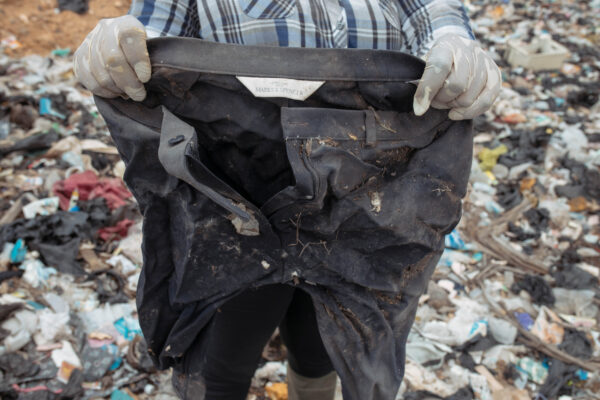 M&S trousers, found in the Weija Ashbread landfill, on the Densu river. © Michael Takyi Lartey / Unearthed / Greenpeace
M&S trousers, found in the Weija Ashbread landfill, on the Densu river. © Michael Takyi Lartey / Unearthed / Greenpeace
“More than 40% of the clothes in each bale cannot be sold… It’s waste, trash, and eventually it ends up on our shores,” he said. “We did not generate that huge chunk of textile waste that we are confronted with, but we are compelled to find a way to deal with it because it is here.”
The Accra region only had one engineered dumpsite: Kpone landfill, a $9.5m (£7.8m) World Bank-funded project which opened in 2013 and was expected to have enough capacity to operate for eight to 10 years. But after five years it was full, partly due to large volumes of fashion waste, and then it ignited thanks to methane trapped beneath the textiles. The fire burned for months.
The World Bank said it had not been actively involved with the Kpone landfill since 2012.
“While the World Bank was not involved in any assessment or intervention related to the devastating fires that occurred at the site in 2019, we remain concerned about the impact of textile waste on the health and sustainable development of the community,” a spokesperson said, adding that the World Bank was financing a new engineered landfill in the north of Accra.
Ghana, like most developing countries, faces significant challenges in managing its waste, including rapid urbanisation, single-use plastics and inadequate sewage disposal. But the volume of textile waste is overwhelming municipal authorities.
Satellite images from Google Earth show the expansion of the Akkaway dump in the Densu Delta protected area from May 2024 to March 2025
Noi calculates that 100 tonnes of garments leave the market daily as waste. The city is able to collect and process just 30 tonnes of this.
“The remaining 70 tonnes end up in waste dumps, drains, lagoons, wetlands and the sea and other environmentally sensitive places,” Noi said.
Soaring over-consumption
Fast fashion has upended the way we dress through rock-bottom prices, rapidly changing collections and aggressive social media marketing. People across the wealthy world are buying more clothes, and wearing them fewer times before discarding them. Brands used to have two main seasons a year; some fast fashion brands now release new “micro-seasons” every week. Globally, the production of clothing has doubled since 2000.
The climate toll is severe: on its current trajectory, by 2050 the fashion industry will represent more than a quarter of the world’s carbon budget, McKinsey’s State of Fashion 2025 report predicts.
People in the UK are Europe’s biggest consumers of fast fashion, buying an estimated 26.7kg of clothing each year – nearly double the amount bought by German consumers, who rank second.
This creates mountains of waste: in the UK, we discard around 1.5m tonnes of used textiles every year, leaving recycling systems struggling to cope. The Textiles Recyclers Association, a trade group, has warned that processing plants are reaching capacity and fast fashion oversupply is pushing the industry close to collapse. Many garments do not get recycled: an estimated 730,000 tonnes of textiles a year are incinerated or landfilled, often after being thrown away in household waste bins. Of the 650,000 tonnes sent to be reused and recycled, over two-thirds (420,000 tonnes) of these were exported, with Ghana receiving more as a final destination than any other country.
 Jeans from Next, found in the Weija Ashbread dump site upriver from the Densu Delta. © Michael Takyi Lartey / Unearthed / Greenpeace
Jeans from Next, found in the Weija Ashbread dump site upriver from the Densu Delta. © Michael Takyi Lartey / Unearthed / Greenpeace
Other African countries, including Uganda, have moved to limit imports of used clothing, arguing that the practice constitutes trade dumping and is stifling local textile industries.
In 2023, a group of Ghanaian traders visited Brussels to argue that the EU should introduce extended producer responsibility (EPR) legislation to hold fashion companies accountable for the end-of-life impact of their products. Similar initiatives already exist for electrical goods, packaging, and batteries.
The UK government published a policy paper on waste prevention in 2023. The paper recognised reducing textile waste as key to net-zero commitments, but did not mention any ongoing consultation on an EPR scheme for textiles. The Textile Recyclers Association has urged the government to implement such a scheme.
Threatened habitat
Ghana’s Densu Delta is a critical biodiversity site, designated a “Ramsar site”: a wetland of “international importance” under the Convention on Wetlands. Sited where the Densu river meanders through mangroves, brackish marshes and salt flats to meet the Atlantic ocean, it supports species such as rare roseate terns, which migrate from the UK, and curlew sandpipers, which visit from the Arctic tundra of Siberia.
Other bird species nest in the estuary, including the black-winged stilt, with its vertiginous bright pink legs. The endangered leatherback and green turtles lay their eggs on the conservation area’s beach, as does the Olive Ridley turtle, known for nesting en masse on the same beach where it hatched. Locals rely on the ecosystem for fishing and salt production.
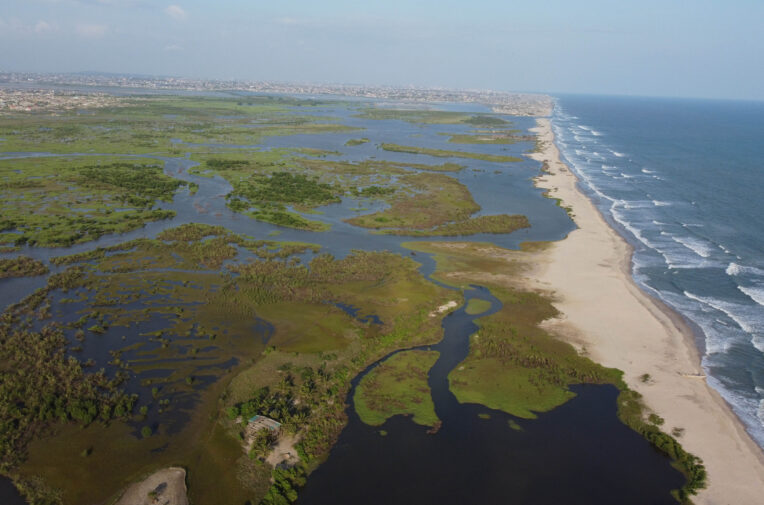 The Densu Delta protected wetlands, outside Accra, Ghana, are designated a “Ramsar site” – a wetland of "international importance" under the Convention on Wetlands. They are home to three species of turtle, and various native and migratory bird species. © Samuel Baidoo / Unearthed / Greenpeace
The Densu Delta protected wetlands, outside Accra, Ghana, are designated a “Ramsar site” – a wetland of "international importance" under the Convention on Wetlands. They are home to three species of turtle, and various native and migratory bird species. © Samuel Baidoo / Unearthed / Greenpeace
But it is now under threat, thanks in part to the international deluge of discarded clothes. Unearthed’s reporters found two recently opened dump sites inside the wetland’s protected area. A third dump upstream on the banks of the Densu also releases garments into the river, which float downstream and pollute the Delta.
Francis Evans Adetsi, a fisherman from a village in the estuary, said that he often pulled up waste textiles in his net.
“Clothes, underwear for men and women, skirts, all come here,” he said. “[Textiles] come here a lot.”
Properly engineered landfills include a lined bottom, a system for collecting and treating leachate, groundwater monitoring, gas extraction and a cap system. But drone footage of the Akkaway dump – the newest site – shows a large area of the wetlands that has had its vegetation removed. Piles of waste sit on bare earth, close to lagoons and streams, with no lining and no other visible pollution mitigation systems.
An official from the area’s local government, Weija Gbawe Municipal Assembly, confirmed to a reporter that it is in charge of the new Akkaway dump and supervises work at this dumpsite. Siting a new dump site in the protected wetlands appears to violate Ghana’s environmental policy and landfill guidelines, as well as the country’s obligations under the Ramsar Convention.
The assembly did not respond to a formal request for comment.
In Tsokomey, a village on the edge of the wetlands, fisherman Daniel Nii Okai blamed waste from upstream dump sites for declining fish stocks.
“For some time now, we do not get [as] much fish [as] we used to,” he said. “The Densu river pushes along all the waste from the dumpsites as it flows into the sea, this destroys where the fish lives and drives them away.”
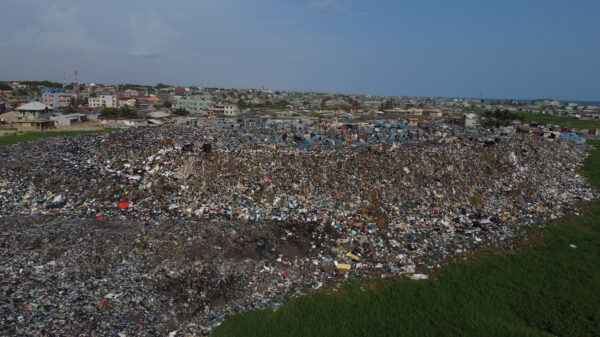 A roughly 4-year-old textile dump site in Glefe, inside the Densu Delta protected wetlands, outside Accra, Ghana. The dump site sits close to lagoons and streams, with no lining and no other visible pollution mitigation systems. © Samuel Baidoo / Unearthed / Greenpeace
A roughly 4-year-old textile dump site in Glefe, inside the Densu Delta protected wetlands, outside Accra, Ghana. The dump site sits close to lagoons and streams, with no lining and no other visible pollution mitigation systems. © Samuel Baidoo / Unearthed / Greenpeace
The city beaches of Accra offer a sobering glimpse of what could happen if dump sites continue to grow and proliferate in the delta. As tidal waters wash over the textiles, they twine together and embed further in the sand, creating “tentacles” of textile waste that can be dozens of metres long.
Barring significant changes, the growth of these dumps seems inevitable. The second dump in the conservation area found by Unearthed, Glefe, has been established for around four years, according to Google Earth historical imagery. It already looms taller than a two-storey building in places. Kofi Owusu, who lives nearby, estimated that around 40 tricycles dump clothes and other refuse at the dump daily.
Locals who depend on the wetlands for their livelihood said they were worried about the impact of the pollution. Saviour Adeti, who has fished in the Densu Delta since he was eight years old, says that he now spends hours untangling “borla” – waste he said consists mostly of clothes tangled with other plastics – from his nets.
 Glefe dump is seen from above. Around four years old, the dump is taller than a two-storey building in places. © Samuel Baidoo / Unearthed / Greenpeace
Glefe dump is seen from above. Around four years old, the dump is taller than a two-storey building in places. © Samuel Baidoo / Unearthed / Greenpeace
“When the borla comes into the water, it disturbs us a lot. When we cast the net, it takes about an hour to remove the borla out of the net.”
When we cast the net, it takes about an hour to remove the [rubbish] out of the net
Seth Tetteh, 31, has lived near the Delta for seven years. “It’s only since three years ago that they started dumping the borla further up [the river]. So when you start fishing and cast your net, it brings in fish, clothes and other things, so it makes the fishermen who use the nets and the boats find it very tedious,” he said. “As, when they go out [fishing], they don’t catch any fish at all because of the borla and garbage…. It’s not easy.”
He added, “Before, you could drink [the river water]. But now, when you go, you can’t drink it. The water is a bit black.”
 Textiles buried in the sand in the Densu Delta wetlands, outside Accra, Ghana. © Michael Takyi Lartey / Unearthed / Greenpeace
Textiles buried in the sand in the Densu Delta wetlands, outside Accra, Ghana. © Michael Takyi Lartey / Unearthed / Greenpeace
Residents near the upstream dump, called Weija Ashbread, told reporters that the dumpsite had transformed their lives since it opened more than five years ago and stripped the landscape of its biodiversity.
Before the Weija Ashbread dumpsite existed, said Ibrahim Sadiq, a 19-year-old student who lives close by, the area was mostly wild.
There were “alligators, bush cats… All kinds of birds and rabbits too,” he said. “[Now] when it rains, there are so many mosquitoes and the smell – it’s very bad.”
Akosua Afriye, who lives close to the dumpsite, said: “When it rains, it lifts up the garbage and spews it all over into the homes, leaving garbage all over… The scent is awful.”
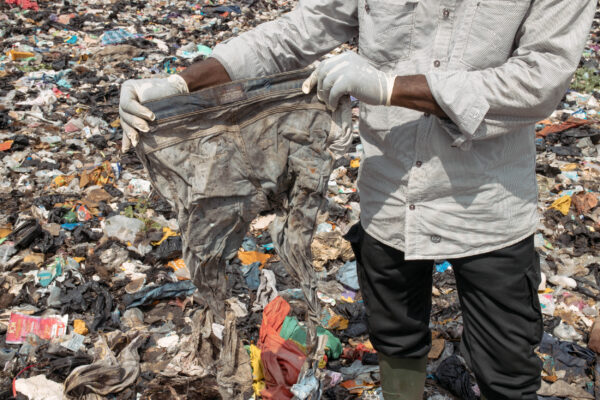 Zara jeans, found in the Weija Ashbread landfill, an older textile dump site sited on the Densu river, upriver from the protected wetlands, outside Accra, Ghana. © Michael Takyi Lartey / Unearthed / Greenpeace
Zara jeans, found in the Weija Ashbread landfill, an older textile dump site sited on the Densu river, upriver from the protected wetlands, outside Accra, Ghana. © Michael Takyi Lartey / Unearthed / Greenpeace
Local businesses have also suffered as waste pollution spreads to recreational areas. At the upscale Bojo Beach resort, in the Densu Delta, textile waste now washes ashore constantly.
“We have to do a lot of cleaning… Normally, used clothes, but also blankets, table cloths,” said Ampah Gabriel, a supervisor. “The sea will bring it in… [the textile waste] is very, very heavy…sometimes you have to get about 10 people pulling it.”
Gabriel said that his team had to spend an average of four hours a day cleaning textile waste and plastic bottles from the beach. Resort staff burn the collected waste every week, he said.
Parsing the less visible, but more insidious effects of the chemicals and microplastics released by clothes as they degrade is difficult.
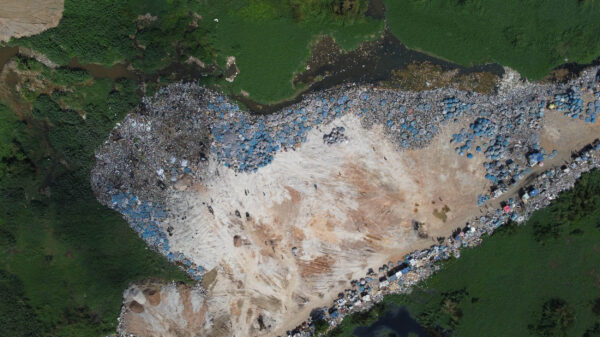 Weija Akkaway, a new dump site for textile and other plastic waste, located inside biodiversity hotspot the Densu Delta protected wetlands, outside Accra, Ghana. © Samuel Baidoo / Unearthed / Greenpeace
Weija Akkaway, a new dump site for textile and other plastic waste, located inside biodiversity hotspot the Densu Delta protected wetlands, outside Accra, Ghana. © Samuel Baidoo / Unearthed / Greenpeace
The European Environment Agency has warned PFAS – so-called “forever chemicals” that have been linked to cancer and other health problems – can be released from textiles in landfills through leachate. The risk of such leakage increases in countries that import large volumes of used clothes and have unregulated waste management systems, the agency noted.
At least 2,400 chemicals are used in textile manufacturing, mainly for washing, dyeing, finishing and printing. About 10% of these pose a health risk. In 2022, a Greenpeace Germany report found hazardous chemicals exceeding EU regulatory limits in clothes and footwear from ultra-fast fashion giant Shein, including high levels of phthalates and BPAs, which are endocrine disruptors.
In the Densu Delta, there are signs that textile waste may be contributing to microplastic pollution. An academic study from 2022 identified plastic fibres, which can come from synthetic clothes, as the most common type of microplastic in oysters from the Gulf of Guinea, with the Densu Delta recording the second-highest incidence of the estuaries studied. However, plastic fibre pollution can also come from fishing gear, and from washing synthetic clothes.
Dr Jones Quartey, a wetland ecologist at the University of Ghana, told Unearthed that disposing of textiles in wetlands could cause irreparable harm.
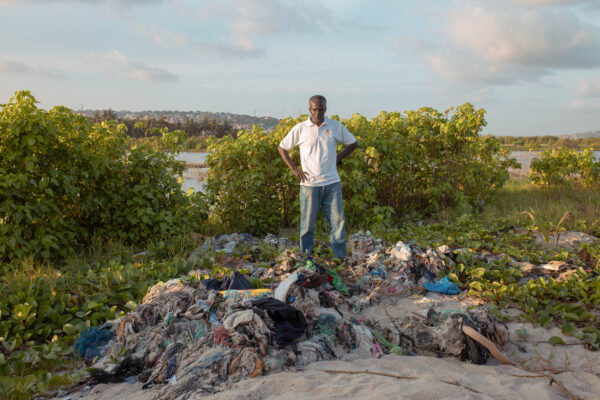 Ampah Gabriel, a supervisor at upscale Bojo Beach resort, in the Densu Delta, outside Accra, Ghana, stands by a pile of textile waste collected from the beach. Gabriel said that his team spend around four hours a day cleaning textile waste and plastic bottles from the beach. Resort staff burn the collected waste every week. © Michael Takyi Lartey / Unearthed / Greenpeace
Ampah Gabriel, a supervisor at upscale Bojo Beach resort, in the Densu Delta, outside Accra, Ghana, stands by a pile of textile waste collected from the beach. Gabriel said that his team spend around four hours a day cleaning textile waste and plastic bottles from the beach. Resort staff burn the collected waste every week. © Michael Takyi Lartey / Unearthed / Greenpeace
“This is dangerous – more so when we don’t know what chemicals are in the textile waste,” he said. “The bioaccumulation and biomagnification of microplastics in aquatic organisms and humans could pose risks such as physical damage, chemical exposure and disruption of biological processes.”
Wetlands perform critical roles in terms of storm water control, water filtration and as a habitat for protected species, he added.
“Dumping of non-biodegradable textiles could alter the structure and function of several habitat types provided by wetlands,” Dr Quartey added. “This will leave in its trail severely fragmented and modified local landscapes.”
A Marks & Spencer spokesperson said the company does not send excess clothing to any other country or landfill.
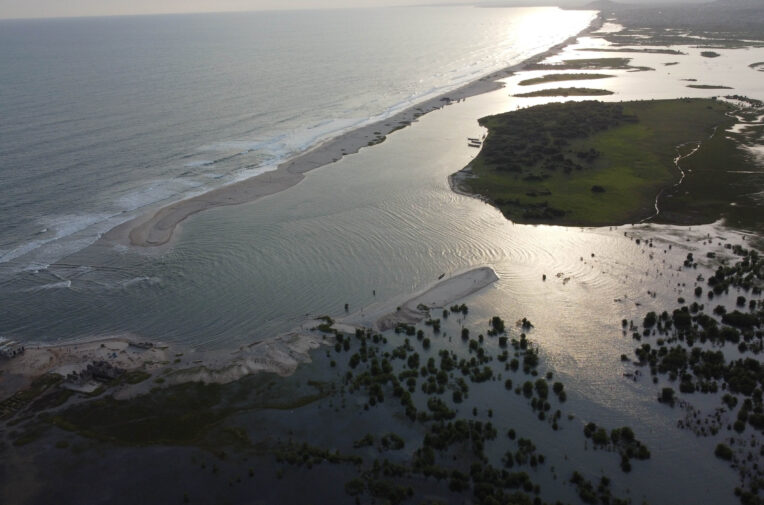 The Densu Delta, outside Accra, Ghana, where it meets the Atlantic Ocean. © Samuel Baidoo / Unearthed / Greenpeace
The Densu Delta, outside Accra, Ghana, where it meets the Atlantic Ocean. © Samuel Baidoo / Unearthed / Greenpeace
“We take our responsibility to provide end of life options for our clothes seriously and offer our customers options to give their clothes another life with our recently launched repair service by SOJO, and with our in-store take back recycling schemes with partners such as Oxfam for clothing and Handle for beauty products, as part of our Plan A to reduce our impact on the planet.”
A spokesperson for George, Asda’s clothing brand, said there had been no increase in the volume of textiles produced or the number of annual fashion seasons it put out over the past ten years, and about 30% of its fibre mix is synthetic. They added that they have over 800 recycling banks and a “take-back” scheme.
“We have a zero-waste policy which applies to our total business,” the spokesperson added. “We would be supportive of exploring a Textile EPR, providing any fees generated are used to improve the recycling infrastructure in the UK.”
A statement from Primark read:
“We never want to see Primark clothes ending up where they shouldn’t. We don’t authorise any of the clothing collected through our customer Textile Takeback scheme or any of our unsold stock to be sent to Ghana or anywhere else in Africa… We know that no single company can solve the issue of textile waste alone. Real progress will only come if the industry comes together. We’re committed to playing our part in these conversations and contributing to collective action that drives lasting change.”
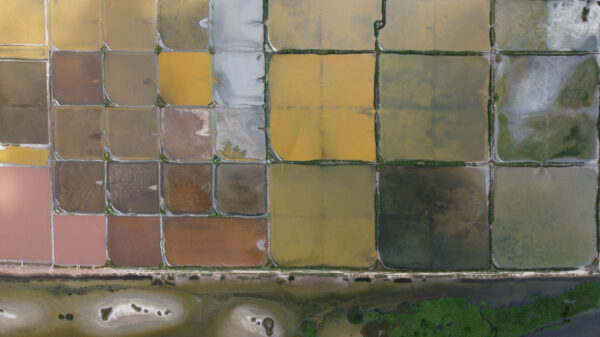 An aerial photograph of saltpans in the Densu Delta Ramsar site, outside Accra, Ghana. Locals rely on the wetlands for fishing and salt production. © Samuel Baidoo / Unearthed / Greenpeace
An aerial photograph of saltpans in the Densu Delta Ramsar site, outside Accra, Ghana. Locals rely on the wetlands for fishing and salt production. © Samuel Baidoo / Unearthed / Greenpeace
H&M acknowledged that the industry faces challenges such as a lack of end-of-life solutions and fully scaled recycling solutions for discarded textiles.
“It is a major problem in our industry and in others, that discarded products are not disposed of properly and could become waste in different countries,” said Marcus Hartmann, H&M’s head of public affairs and sustainability in the UK. “While this is an industry-wide challenge, we acknowledge our role in contributing to the problem, notably when our products reach markets with inadequate or no waste management or recycling infrastructures.”
He added that: “Since January 2025, we only source recycled polyester. Polyester currently represents approximately 22% of our material basket.”
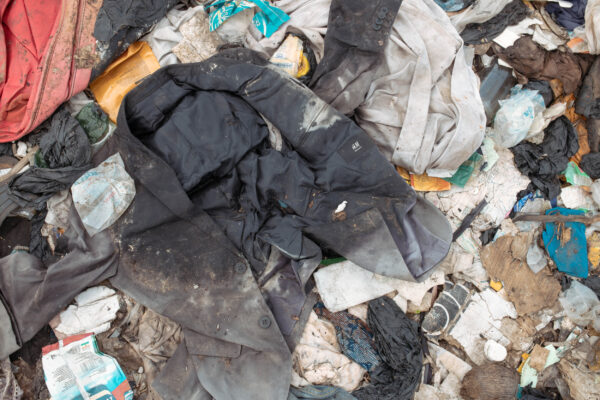 An H&M jacket, found in the Weija Ashbread landfill, a textile dump site sited on the Densu river, upriver from the protected wetlands, outside Accra, Ghana. © Michael Takyi Lartey / Unearthed / Greenpeace
An H&M jacket, found in the Weija Ashbread landfill, a textile dump site sited on the Densu river, upriver from the protected wetlands, outside Accra, Ghana. © Michael Takyi Lartey / Unearthed / Greenpeace
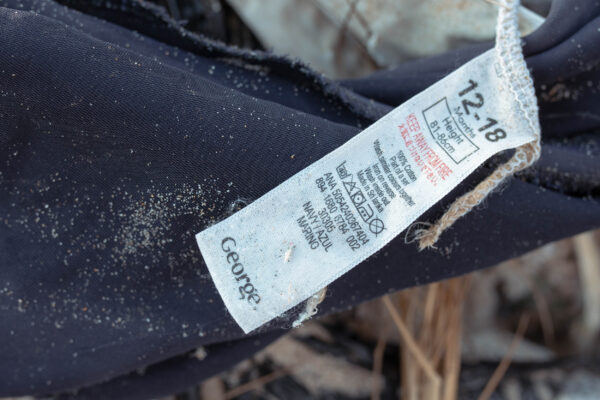 A garment from George (Asda) found in textile waste washed up in the Densu Delta protected wetlands. © Michael Takyi Lartey / Unearthed / Greenpeace
A garment from George (Asda) found in textile waste washed up in the Densu Delta protected wetlands. © Michael Takyi Lartey / Unearthed / Greenpeace
A spokesperson for Zara’s parent company, Inditex, said that Zara still puts out two annual seasons and that the proportion of synthetic fibres used in 2024 was 37%. The company would support an EPR policy mandated by the government, Inditex said.
“We believe that advancing toward common legislation in this field will establish a unified framework that sets the same rules for all players. We understand that the separate collection of textile waste is the foundation of a circular model. That is why we not only promote new textile recycling technologies but also develop the necessary capabilities to make them feasible.”
Next did not respond to a request for comment.
.png)



